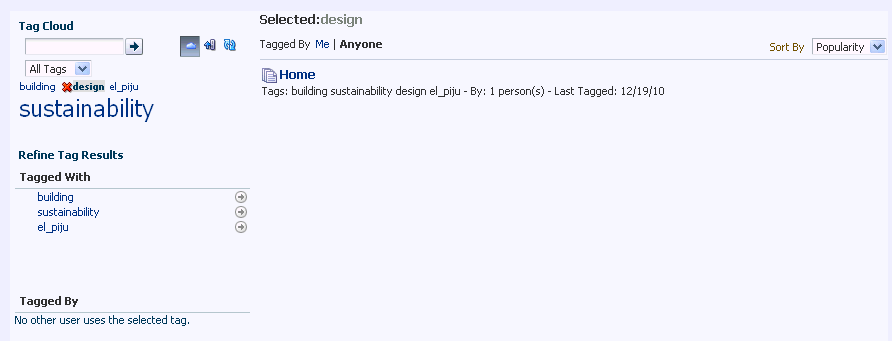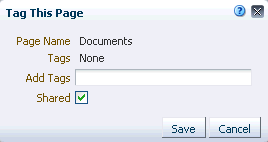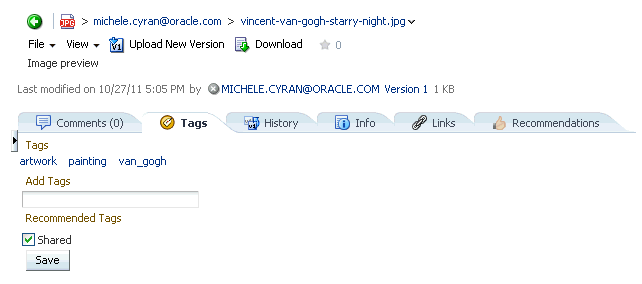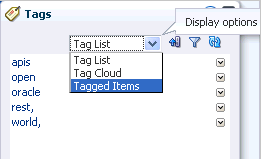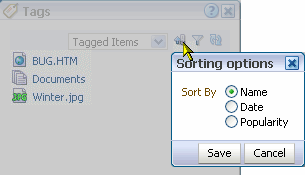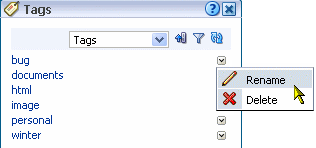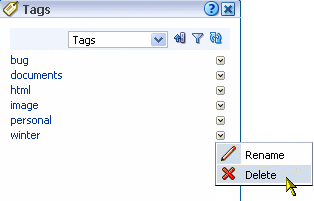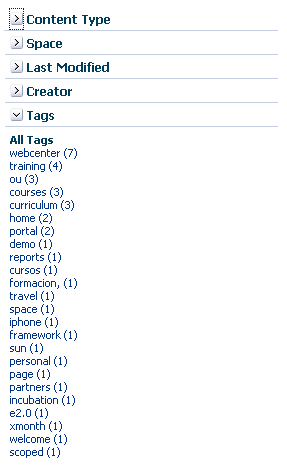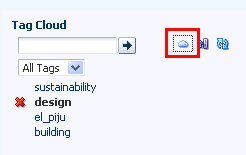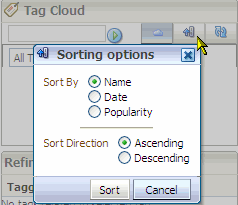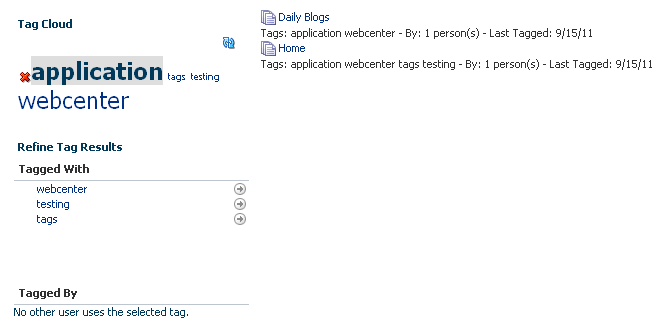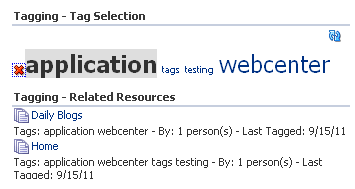57 Working with the Tags Service
This chapter describes how to use the features provided through the Tags service. Tagging enables users to apply their own meaningful terms to application items, making those items more easily discoverable in search results and the Tag Center.
This chapter includes the following sections:
This chapter is intended for users who want to use and manage tags. Such users must be granted, minimally, the space-level permission View Pages and Content to view tags. They can view shared tags only for resources for which they have view permission.
Authenticated users who plan to create and manage tags require the space-level permission Customize Pages and Edit Content. They must have view permission on the resource.
WebCenter Portal: Spaces administrators with the Application-Manage Configuration permission and individual space moderators can add tags to a page template. Page creation permissions are required to add task flows to a page. For more information, see Section 52.2.1.2, "Understanding Permissions and Permission Models in a Space."
Note:
Tasks discussed in this chapter may not be available if the Tags service is not enabled in the current space.
57.1 What You Should Know About the Tags Service
The Tags service provides a means of bookmarking application objects, making them easy to locate the next time you go looking for them. You can tag pages and documents in WebCenter Portal applications. This section provides an overview of the Tags service: what tags are and how to use tags. It contains the following subsections:
57.1.1 Understanding Tags
A tag is a word you associate with application pages or documents, applying your own classification to improve search results. For example, you could apply the tag jcr to a page that provides useful insight into Java Content Repositories. When you search for information about JCRs, the tagged page appears in the results.
Tags are available for viewing in the Tags task flow, in search results, and in the Tag Center, where you can see what tags were used and what items were tagged. Tagging assists with building a knowledge network where each user can benefit from the assessments of all users.
Your tags help provide a higher level of relevance from search results for yourself and others by augmenting results with relevant items that you or others have tagged. Additionally, classifying an item with a tag enables you to gather disparate items into a cohesive body of knowledge and share it with others.
You have the option of sharing tags or keeping them to yourself. Share tags to enable other users to discover them in their searches. When you do not share a tag, users searching on an identical term do not discover the items you tagged with that term, unless some other user tagged the item with the same term and shared that tag.
Anywhere you see the Tags icon (Figure 57-1), you can apply a tag.
When you place your cursor over the Tags icon, you see a list of any tags you have applied to the item and the tags that have been applied most frequently to the item by you and other users. To see the items associated with a displayed tag, click the tag.
When looking at tags in search results, note the number of times the tag was applied to a particular object. This number indicates the tag's relevance to that object, and ultimately causes a collective classification scheme popularly known as a folksonomy. This can make information easier to search and navigate over time.
The scope of tags is both personal and application-wide. The tag data you view in the Tags task flow includes only the tags you apply; however, when you tag data through the Tag Center or through a Tags service task flow you see application-wide tag data.
Application-wide (global) searches look for tagged items wherever they might be. You can run global searches from the search field near the top-right of the application.
You can provide one or multiple tags to a given item. And multiple users can use the same tag term that you used and apply it to the same item. Duplicates of tags across users are tabulated and provide extra weight to the relevance of the tag term.
57.1.2 Understanding the Tag Center
The Tag Center is a dynamically-generated page that displays all the tags you and other users have applied to application pages and documents (Figure 57-2).
The Tag Center offers the most complete use of tag data by providing access not only to your tags, but to the tags applied by other users. Additionally it provides a visual depiction of tag popularity, which enables you to refine tag results using filters. Filter for multiple tags simultaneously or filter by other users who have applied the same tags. A sorting feature provides an additional means of controlling your view of tagged items.
The Tag Center has three sections:
-
The Tag Cloud section, which you can use to view a cloud or list of the tags currently applied to items in your application.
-
The Refine Tag Results section with two types of list: a list of all other tags used on items that also use the currently-selected tag and a list of other users who have applied the selected tag.
-
The Selected tag section, which provides a list of all items to which you have access that use the currently-selected tag and options to edit, sort, and filter the items.
The Tag Cloud is a visual depiction of currently-applied tags (Figure 57-3).
Tags are presented according to the frequency of their use. More frequently used tags display in bold fonts and varying font sizes—the larger the font, the more the tag has been applied. Click a tag in the tag cloud to execute a search that returns a list of all items to which you have access that use the tag.
To learn how to work with tags in the Tag Center see Section 57.2.7, "Working with Tags and Tagged Items in the Tag Center."
57.2 Working with Tags Service Features and Task Flows
This section provides information about tagging and describes how to make best use of tags. It includes the following subsections:
-
Section 57.2.5, "Working with Tags and Tagged Items in the Tags Task Flow"
-
Section 57.2.6, "Viewing Tags and Tagged Items in Search Results"
-
Section 57.2.7, "Working with Tags and Tagged Items in the Tag Center"
-
Section 57.2.8, "Understanding the Tag Cloud and the Tag Selection Task Flows"
-
Section 57.2.9, "Understanding the Similarly Tagged Items Task Flow"
57.2.1 Adding a Tags Service Task Flow to a Page
For the steps to add a Tags service task flow to a page, see Section 17.5, "Adding Resource Catalog Components to Pages."
57.2.2 Adding the Tags Icon to Pages
If you do not see the Tags icon on pages, then your WebCenter Portal administrator or space moderator must follow these steps to add the Tags icon to pages.
-
On the Administration - Resources tab, edit the page template. Select Edit - Copy, and enter a meaningful name for this new page template (Figure 57-4).
-
Click Edit - Edit, and add the Tags icon to the template page. For example, at the top of the page, click Add Content, click to open the Template Development folder, and then click to add Tags.
-
Click Save, then Close to stop editing the template.
-
On the Administration - Resources - Page Templates tab, select this template. Click Edit - Show to make the template available.
-
On the Administration - Configuration - General tab, set this new template as the Default Page Template, and click Apply.
The Tags icon displays on the page (Figure 57-5).
57.2.3 Tagging Application Pages
This section steps you through the process of applying tags to application pages. You can apply a tag to any application page on which you see the Tags icon and link (Figure 57-6).
To tag a page in your application:
-
Go to the page you want to tag.
-
Click the page's Tags icon or link.
The Tag this Page dialog opens (Figure 57-7).
-
Enter tag values:
-
Page Name—The page's display name, a read-only value.
-
Tags—List of tags already applied to this page.
-
Add Tags—Enter one or more tags, separated with a space. Use underscores or hyphens in multi-word tag entries.
-
Shared—Imagine that you have tagged a page with the term essential and selected the Shared checkbox. When other users search using the term essential, the page you tagged appears in their search results. If you clear the Shared checkbox, then other users' search on the term essential does not include this page in their results (unless others, too, have tagged it essential or another user tagged it essential and shared the tag). Regardless of whether you select or clear Shared, when you search on the term essential, the page you tagged with that term appears in your search results.
If your administrator disabled the Shared checkbox, then it does not appear.
-
-
Click Save to apply the tag and close the dialog.
Note:
For information about tags and searches, see Section 57.2.6, "Viewing Tags and Tagged Items in Search Results."
57.2.4 Tagging Application Documents
The section steps you through the process of applying tags to documents. You can apply tags to any documents you can view.
To tag a document in your application:
-
Go to a Document Library main view, either the task flow or the Documents page, and locate the document you want to tag.
-
Click the document to open it, then click Tags icon. The Tags section displays the tags you have put on the document. It also lets you update these tags and add new tags. (Figure 57-8).
-
Enter tag values:
-
Tags—List of tags already applied to this page.
-
Add Tags—Enter one or more tags, separated with a space. Use underscores or hyphens in multi-word tag entries.
-
Recommended Tags—Recommended tags are automatically generated using a ranking algorithm. They indicate the system's best estimation of tags that suit the document you are currently tagging. Click a recommended tag to add it to the Tags field.
-
Shared—Imagine that you have tagged a document with the term essential and selected the Shared checkbox. When other users search using the term essential, the document you tagged appears in their search results. If you clear the Shared checkbox, then other users' search on the term essential does not include this document in their results (unless they, too, have tagged it essential). Regardless of whether you select or clear Shared, when you search on the term essential, the document you tagged with that term appears in your search results.
If your administrator disabled the Shared checkbox, then it does not appear.
-
-
Click Save to apply the tag.
Note:
For information about tags and searches, see Section 57.2.6, "Viewing Tags and Tagged Items in Search Results."
57.2.5 Working with Tags and Tagged Items in the Tags Task Flow
This section describes how to work with tags in the Tags task flow. It contains the following subsections:
57.2.5.1 Viewing Tags and Tagged Items in the Tags Task Flow
The Tags task flow (available in the Composer Catalog) provides a view of the tags you have added to your application and the items you have tagged (Figure 57-9).
You can use the Tags task flow to navigate to a tag's associated resources or to open the Tag Center and further refine your resource selection (see Section 57.2.7, "Working with Tags and Tagged Items in the Tag Center"). You can also use it to display a tag cloud or the items you have tagged in your application.
To view a tag cloud depiction of your tags, choose Tag Cloud.
To view tagged items, choose Tagged Items from the display options menu. The task flow redraws to display all the items that you have tagged in your application.
57.2.5.2 Sorting Tags and Tagged Items
When your tag list is long, sorting the list makes it easier to find specific tags. Sort the tag list by name, date, or popularity. This section describes how.
To sort the tags in the Tags task flow:
-
Click the Sorting options icon at the top of the Tags task flow.
The Sorting options dialog opens (Figure 57-10).
-
From the Sorting options dialog, choose a sorting criteria.
Choose from:
-
Name—Sorts the list alphabetically from 1 to 9 and a to z.
-
Date—When tags are shown, Date sorts the list from the tags you applied most recently to the oldest tags you applied. When tagged items are shown, Date sorts the list from the items you tagged most recently to the items with the oldest tags you applied.
-
Popularity—When tags are shown, Popularity sorts the list from the tags you have applied most frequently to those you have applied least frequently. When tagged items are shown, Popularity sorts the list from the items that have been tagged by the most people to the items tagged by the fewest.
-
-
Click Save to apply your selection and close the dialog.
57.2.5.3 Filtering Tags and Tagged Items
Filtering provides a way to eliminate all tags on the list except for those that meet the filtering criteria. This section describes how to apply a filter to the Tags list in the Tags task flow:
To filter the Tags list in the Tags task flow:
-
Click the Filter icon to open a filtering term field (Figure 57-11).
Filtering works for both Tags and Tagged Items views of the task flow.
-
Enter a filtering term, and click the Search icon.
The Tags list refreshes, showing only those tags that match or include the filtering term.
-
Clear the filtering term, and click the Search icon to restore all of your tags to view.
-
Click the Filter icon to exit filtering.
57.2.5.4 Renaming a Tag from the Tags Task Flow
When you rename a tag, you rename all instances of the tag that you applied. If other users applied the same tag, their instances are not renamed.
To rename tags from the Tags task flow:
-
Choose Rename from the menu next to the tag you want to rename (Figure 57-12).
-
In the Rename dialog, enter a new name for the selected tag, and click Rename (Figure 57-13).
All of the tags you created using the original tag name, are renamed.
57.2.5.5 Deleting a Tag from the Tags Task Flow
When you delete a tag, it is deleted wherever you applied it. If others applied the same tag, their tags are left as is.
To delete a tag from the Tags task flow:
-
Choose Delete from the menu next to the tag you want to delete (Figure 57-14).
-
Click Delete in the Delete dialog (Figure 57-15).
The tag is removed from the Tags task flow and from any items to which you applied it.
57.2.6 Viewing Tags and Tagged Items in Search Results
Tag search results appear under two headings:
-
Tags, which shows tags that at least partially match the search criteria; for example, if you search for page, the following tags are returned: page, pages, or pager.
-
Tagged Items, which shows items that are associated with a tag that matches the search criteria exactly; for example, if you search for page, only items associated with the tag page are returned; items associated with the following tags are not returned: pages or pager.
Under these headings, tag search results appear like any other search results; however, tags in tag search results behave a little differently. When you click tagged items in tag search results or when you click other types of search results, their associated content is shown. When you click a tag in tag search results, the Tag Center opens with that tag preselected.
To view tags and tagged items in search results:
-
Run a search as described in Section 56.2, "Searching in Your Application."
-
The search results open in the Search page (Figure 57-16). The Tags section shows the number of items to which a tag has been applied. The Tagged Items section shows the number of users who have applied a tag to an item.
Note:
Results appear different if you are using WebCenter Portal's live search adapters or Oracle SES for the search engine. For more information, see Section 56.1.1, "Using the Oracle Secure Enterprise Search Adapter."
57.2.7 Working with Tags and Tagged Items in the Tag Center
This section describes how to work with tags in the Tag Center. It contains the following subsections:
57.2.7.1 Opening the Tag Center
There are several ways to open the Tag Center (Figure 57-17):
-
Click a tag displayed in the Tags task flow
-
Click a tag returned as a search result
-
Click a tag that appears when you hover over the Tags icon
Additionally, the administrator can add a page for the Tag Center in the Home space.
The selected tag determines all the other tag-related information that appears in the Tag Center. For example:
-
The selected tag is highlighted in the tag cloud (Figure 57-18).
You can choose another tag in the tag cloud to change the information that is displayed in the Tag Center. Additionally, you can use the controls above the tag cloud to rearrange your tag-cloud view (see Section 57.2.7.2, "Selecting Different Views and Arrangements of Tags in the Tag Cloud").
-
Other tags used on items that also use the currently-selected tag display in the Tagged with panel (Figure 57-19).
-
Other users who applied the selected tag are listed in the Tagged by panel (Figure 57-20).
-
Items tagged with the currently-selected tag appear in the right panel of the Tag Center (Figure 57-21). Click an item link to display the item.
57.2.7.2 Selecting Different Views and Arrangements of Tags in the Tag Cloud
The Tag Center's Tag Cloud displays the tags currently applied to items. You can adjust your view of the Tag Cloud using its sorting and filtering features.
To display the tag cloud:
-
Open the Tag Center as described in Section 57.2.7.1, "Opening the Tag Center."
The Tag Center opens with the tag cloud displayed in the top left corner (Figure 57-22).
To adjust your view of the tag cloud:
-
To search for tags, enter a search term in the text box on the tag cloud toolbar, and click the Search icon to the right of the text box.
The tag display refreshes showing only those tags that meet the search criteria. To show just your matching tags or to remove the search criteria, choose an option from the menu above the tag cloud:
-
All Tags—Removes the search criteria, showing every tag used in your application
-
My Tags—Removes the search criteria, showing just the tags you have applied
-
All tags containing '<search term>'—Shows all tags in your application that meet the search criteria
-
My tags containing '<search term>'—Shows just the tags which you have applied that meet the search criteria
-
-
To switch between displaying the tags in cloud view or list view, click the cloud icon (Figure 57-23).
-
To sort the tags:
-
Click the Sorting options icon on the tag cloud toolbar.
The Sorting options dialog opens (Figure 57-24).
-
From the Sorting options dialog, choose sorting criteria.
Choose from:
-
Name—Sorts the list alphabetically. If you choose Ascending, the list is sorted from 1 to 9 and a to z. If you choose Descending, the list is sorted from z to a and 9 to 1.
-
Date—Sorts the list based on when you applied the tags. If you choose Ascending, the tags are sorted from the ones you applied most recently to the ones applied longest ago. If you choose Descending, the tags are sorted from the ones applied longest ago to the ones applied most recently.
-
Popularity—Sorts the list based on how frequently the tag has been applied. If you choose Ascending, the tags are sorted from the ones that have been applied most frequently to the one that have been applied least frequently. If you choose Descending, the tags are sorted from the ones applied least frequently to the ones applied most frequently.
-
-
Click Sort to apply your selection and close the Sorting options dialog.
-
-
To refresh the list of tags, click the Refresh tags icon.
-
To show all tags or just your tags, choose an option from the menu above the tag cloud:
-
All Tags—Shows every tag used in your application
-
My Tags—Shows just the tags you have applied
-
57.2.7.3 Selecting Different Views and Arrangements of Tagged Items
The Tag Center provides a selection of sorting criteria to enable you to display tagged items in the way that you prefer. Using the Tagged by and Sort By options above the list of tagged items (Figure 57-25), you can choose which tags to show and the order in which to show them.
To choose the tagged items to view, choose from:
-
Tagged by Me—Click to show only the items that use the selected tag that you have tagged yourself.
-
Tagged by Anyone—Click to show all items that use the selected tags.
To arrange the order of displayed tagged items, choose from:
-
Popularity—To sort the list from items that have been tagged most frequently with the current tag to those tagged least frequently
-
Name—To sort the list alphabetically from 1 to 9 and a to z
-
Date—To sort the list from items that have been tagged most recently to the ones tagged longest ago
57.2.7.4 Refining the Display of Information in the Tag Center
You can further refine your view of information in the Tag Center by selecting additional tags in the Tagged with panel (Figure 57-26).
The Tagged with panel displays all the other tags used on objects that also use the currently-selected tag. Click a tag in the Tagged with panel to further restrict the information in the Tag Center to information associated with both the selected tag and the related tag you clicked.
For example, imagine that the Tag Center displays all items tagged with the term help. Click jcr_docs in the Tagged with panel to further refine the information in the Tag Center to information that is associated with both help and jcr_docs.
57.2.7.5 Discovering Who Has Used a Tag in the Tag Center
You can further refine your view of information in the Tag Center by selecting other users in the Tagged by panel (Figure 57-27).
The Tagged by panel lists all other users who have applied the selected tag or tags. Click a user in the Tagged by panel to limit the information in the Tag Center to information tagged with the selected tag and also tagged by the user you clicked.
Using Figure 57-27 as an example, and assuming the currently-selected tag is help, clicking orcladmin shows information associated with the tag help, applied by orcladmin.
57.2.8 Understanding the Tag Cloud and the Tag Selection Task Flows
The Tag Cloud task flow and Tag Selection task flow are similar in that they both display a tag cloud, which is a visual depiction of all the tags used. Tags are presented according to the frequency of their use. More frequently used tags display in bold fonts and varying font sizes—the larger the font, the more the tag has been applied.
With the Tag Cloud task flow (Figure 57-28), when you click a tag in the tag cloud, you are redirected to Tag Center, where that tag is selected (Figure 57-29).
With the Tag Selection task flow (Figure 57-30), when you click a tag, it marks the tag as selected and you see the results in the Tag Cloud Related Resources task flow (Figure 57-31). You are not redirected to the Tag Center.
57.2.9 Understanding the Similarly Tagged Items Task Flow
The Similarly Tagged Items task flow (Figure 57-32) provides a list of links to other pages or documents that have at least one tag in common with the currently-displayed page.
57.3 Setting Tags Service Task Flow Properties
The Tags service task flow has associated properties, which users with sufficient privileges can access from the Component Properties dialog in Oracle Composer (Figure 57-33).
Figure 57-33 Similarly Tagged Items Task Flow Properties
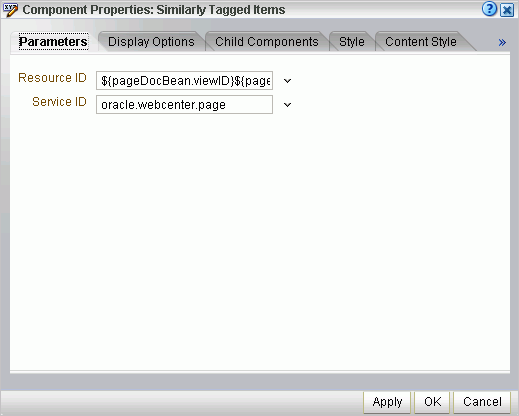
Description of "Figure 57-33 Similarly Tagged Items Task Flow Properties"
For information about accessing the Component Properties dialog, see Section 17.5.2.3, "Setting Component Properties."
The following sections provide information about properties of the Tags service task flows and describe the properties on the Parameters tab.
57.3.1 What You Should Know About the Tags Service Task Flow Properties
The properties on the Parameters tab of the Component Properties dialog control the default task flow content. For descriptions of the parameters on this tab, see Section 57.3.2, "Tags Service Task Flow Parameters." For some task flows, parameters on this tab facilitate the wiring of the task flow to page parameters and page definition variables. For more information, see Chapter 19, "Wiring Pages, Task Flows, Portlets, and UI Components."
Changes to the properties on the Display Options, Style, and Content Style tabs affect the appearance and behavior of the task flow for all users. These properties are common to all task flows. For more information, see Section 17.5.2, "Setting Properties on Page Components."
The content of the Events tab depends on the events supported by the task flow. For more information, see Section 17.5.2.8, "Working with Component Contextual Events."
The Child Components tab displays all of the components contained within the current component. It provides controls for rearranging, showing, and hiding child components. Not all components contain children. So this tab may be omitted. For more information, see Section 17.5.2.6, "Working with Child Components."
All properties on the Parameters and Display Options tabs provide access to an Expression Language (EL) editor, which you can use to select or specify a variable value instead of a constant value. Click the Edit icon next to a property field to open the editor. For more information about ELs in Spaces, see Appendix B, "Expression Language Expressions."
Note:
Wherever you enter EL on the generic Display Options tab in the Component Properties dialog, the entry is automatically validated. If the EL is invalid, an error appears and the value is neither applied nor saved. Generic Display Options are those cataloged in Table 17-1.
EL validation is not performed on non-generic display options.
57.3.2 Tags Service Task Flow Parameters
Table 57-1 describes the parameters that are unique to the Tags service task flows.
Table 57-1 Tags Service Task Flow Parameters
| Parameter | Description | Task Flow |
|---|---|---|
|
Unique ID of the item or resource within a given service that is used to find similarly tagged items. This value is set automatically. Do not change this value unless you want to show items similar to a different resource. |
Tagging - Related Links Similarly Tagged Items |
|
|
This parameter has a different meaning for the Similarly Tagged Items task flow and the Tags task flow.
|
Tagging - Related Links Similarly Tagged Items Tagging - Personal View Tags |
|
|
Scope of tags. This value is set automatically. Do not change this value. |
Tag Cloud Tag Selection Tagging - Tagged Items Tag Cloud Related Resources |
|
|
Redirection URL for anonymous page login. This must include the |
Tagging Dialog |
Note:
You should not change the Tags service task flow properties unless you want to show items from a different resource or different service.
